Non-Thermal Plasma (NTP) Treatment of Alfalfa Seeds in Different Voltage Conditions Leads to Both Positive and Inhibitory Outcomes Related to Sprout Growth and Nutraceutical Properties
Abstract
1. Introduction
2. Results
2.1. Seed Analyses
2.1.1. Microimaging of the Seed Surface
2.1.2. Water Contact Angle of the Seed Surfaces
2.2. Biometric Measurements
2.3. Biochemical Measurements
2.4. Pearson Correlation
3. Discussion
4. Materials and Methods
4.1. Seed Preparation and Sprout Growth
4.2. Plasma Device and Treatment Conditions
4.3. Seed Analyses
4.3.1. Microimaging and Chemical Analysis of the Seed Surface
4.3.2. Water Contact Angle of the Seed Surface
4.4. Biometric Measurements
4.5. Biochemical Measurements of Some Nutraceutical Compounds
4.6. Statistical Analysis
5. Conclusions
Author Contributions
Funding
Data Availability Statement
Conflicts of Interest
References
- Gudyniene, V.; Juzenas, S.; Stukonis, V.; Mildaziene, V.; Ivankov, A.; Norkeviciene, E. Comparing Non-Thermal Plasma and Cold Stratification: Which Pre-Sowing Treatment Benefits Wild Plant Emergence? Plants 2023, 12, 3220. [Google Scholar] [CrossRef] [PubMed]
- Šerá, B.; Jirešová, J.; Scholtz, V.; Julák, J.; Khun, J. Non-Thermal Plasma Treatment Improves Properties of Dormant Seeds of Black Locust (Robinia pseudoacacia L.). Forests 2023, 14, 471. [Google Scholar] [CrossRef]
- Ďurčányová, S.; Slováková, Ľ.; Klas, M.; Tomeková, J.; Ďurina, P.; Stupavská, M.; Kováčik, D.; Zahoranová, A. Efficacy Comparison of Three Atmospheric Pressure Plasma Sources for Soybean Seed Treatment: Plasma Characteristics, Seed Properties, Germination. Plasma Chem. Plasma Process 2023, 43, 1863–1885. [Google Scholar] [CrossRef]
- Attri, P.; Okumura, T.; Takeuchi, N.; Razzokov, J.; Zhang, Q.; Kamataki, K.; Shiratani, M.; Koga, K. Role of Direct Plasma Irradiation, Plasma-Activated Liquid, and Plasma-Treated Soil in Plasma Agriculture. Plasma Med. 2023, 13, 33–52. [Google Scholar] [CrossRef]
- Motrescu, I.; Lungoci, C.; Ciolan, M.A.; Jitareanu, G. Non-thermal plasma (NTP) treatment of Trigonella foenum-graecum L. seeds stimulates the sprout growth and the production of nutraceutical compounds. BMC Plant Biol. 2024, 24, 33. [Google Scholar] [CrossRef]
- Eto, H.; Ono, Y.; Ogino, A.; Nagatsu, M. Low-temperature sterilization of wrapped materials using flexible sheet-type dielectric barrier discharge. Appl. Phys. Lett. 2008, 93, 221502. [Google Scholar] [CrossRef]
- Kungsuwan, K.; Sawangrat, C.; Ounjaijean, S.; Chaipoot, S.; Phongphisutthinant, R.; Wiriyacharee, P. Enhancing Bioactivity and Conjugation in Green Coffee Bean (Coffea arabica) Extract through Cold Plasma Treatment: Insights into Antioxidant Activity and Phenolic–Protein Conjugates. Molecules 2023, 28, 7066. [Google Scholar] [CrossRef] [PubMed]
- Doshi, P.; Šerá, B. Role of Non-Thermal Plasma in Fusarium Inactivation and Mycotoxin Decontamination. Plants 2023, 12, 627. [Google Scholar] [CrossRef] [PubMed]
- Butscher, D.; Van Loon, H.; Waskow, A.; von Rohr, P.R.; Schuppler, M. Plasma inactivation of microorganisms on sprout seeds in a dielectric barrier discharge. Int. J. Food Microbiol. 2016, 238, 222–232. [Google Scholar] [CrossRef]
- Bozhanova, V.; Marinova, P.; Videva, M.; Nedjalkova, S.; Benova, E. Effect of Cold Plasma on the Germination and Seedling Growth of Durum Wheat Genotypes. Processes 2024, 12, 544. [Google Scholar] [CrossRef]
- Šera, B.; Šery, M. Non-thermal plasma treatment as a new biotechnology in relation to seeds, dry fruits, and grains. Plasma Sci. Technol. 2018, 20, 044012. [Google Scholar] [CrossRef]
- Paredes-Lopez, O.; Osuna-Castro, J.A. Molecular Biotechnology for Nutraceutical Enrichment of Food Crops: The Case of Mineral and Vitamins. In Functional Foods and Biotechnology; Shetty, K., Paliyath, G., Pometto, A.L., Levin, R.E., Eds.; CRCTaylor & Francis: Boca Raton, NY, USA, 2007. [Google Scholar]
- Francis, H.; Debs, E.; Koubaa, M.; Alrayess, Z.; Maroun, R.G.; Louka, N. Sprouts Use as Functional Foods. Optimization of Germination of Wheat (Triticum aestivum L.), Alfalfa (Medicago sativa L.), and Radish (Raphanus sativus L.) Seeds Based on Their Nutritional Content Evolution. Foods 2022, 11, 1460. [Google Scholar] [CrossRef] [PubMed]
- Tarasevičienė, Ž.; Viršilė, A.; Danilčenko, H.; Duchovskis, P.; Paulauskienė, A.; Gajewski, M. Effects of germination time on the antioxidant properties of edible seeds. CyTA-J. Food 2019, 17, 447–454. [Google Scholar] [CrossRef]
- Zieliński, H.; Frias, J.; Piskuła, M.K.; Kozłowska, H.; Vidal-Valverde, C. Vitamin B 1 and B 2, dietary fiber and minerals content of Cruciferae sprouts. Eur. Food Res. Technol. 2005, 221, 78–83. [Google Scholar] [CrossRef]
- Chiriac, E.R.; Chiţescu, C.L.; Sandru, C.; Geană, E.-I.; Lupoae, M.; Dobre, M.; Borda, D.; Gird, C.E.; Boscencu, R. Comparative Study of the Bioactive Properties and Elemental Composition of Red Clover (Trifolium pratense) and Alfalfa (Medicago sativa) Sprouts during Germination. Appl. Sci. 2020, 10, 7249. [Google Scholar] [CrossRef]
- Oleszek, M.; Oleszek, W. Saponins in Food. In Handbook of Dietary Phytochemicals; Xiao, J., Sarker, S., Asakawa, Y., Eds.; Springer: Singapore, 2020; pp. 6–8. [Google Scholar] [CrossRef]
- Li, Z.; Wang, Y.; Liu, J.; Chen, D.; Feng, G.; Chen, M.; Feng, Y.; Zhang, R.; Yan, X. The potential role of alfalfa polysaccharides and their sulphated derivatives in the alleviation of obesity. Food Funct. 2023, 14, 7586–7602. [Google Scholar] [CrossRef] [PubMed]
- Zhang, K.; Li, H.; Zhang, T.; Wang, S.; Liu, L.; Cong, L.; Song, H.; Wang, A.; Yang, G.; Xie, H.; et al. Comprehensive transcriptomic and metabolomic profiling reveals the differences between alfalfa sprouts germinated with or without light exposure. Front. Plant Sci. 2022, 13, 943740. [Google Scholar] [CrossRef]
- Shi, Y.; Guo, R.; Wang, X.; Yuan, D.; Zhang, S.; Wang, J.; Wang, C. The regulation of alfalfa saponin extract on key genes involved in hepatic cholesterol metabolism in hyperlipidemic rats. PLoS ONE 2014, 9, e88282. [Google Scholar] [CrossRef] [PubMed]
- Canivenc-Lavier, M.C.; Bennetau-Pelissero, C. Phytoestrogens and Health Effects. Nutrients 2023, 15, 317. [Google Scholar] [CrossRef]
- Šerá, B.; Scholtz, V.; Jirešová, J.; Khun, J.; Julák, J.; Šerý, M. Effects of Non-Thermal Plasma Treatment on Seed Germination and Early Growth of Leguminous Plants—A Review. Plants 2021, 10, 1616. [Google Scholar] [CrossRef]
- Holc, M.; Gselman, P.; Primc, G.; Vesel, A.; Mozetič, M.; Recek, N. Wettability and Water Uptake Improvement in Plasma-Treated Alfalfa Seeds. Agriculture 2022, 12, 96. [Google Scholar] [CrossRef]
- Feng, J.; Wang, D.; Shao, C.; Zhang, L.; Tang, X. Effects of cold plasma treatment on alfalfa seed growth under simulated drought stress. Plasma Sci. Technol. 2018, 20, 035505. [Google Scholar] [CrossRef]
- Motrescu, I.; Ciolan, M.A.; Calistru, A.E.; Jitareanu, G. Germination and growth improvement of some micro-greens under the influence of reactive species produced in non-thermal plasma (NTP). Agronomy 2023, 13, 150. [Google Scholar] [CrossRef]
- Staric, P.; Mravlje, J.; Mozetic, M.; Zaplotnik, R.; Setina Batic, B.; Junkar, I.; Vogel Mikus, K. The influence of Glow and Afterglow Cold plasma treatment on Biochemistry, morphology, and physiology of wheat seeds. Int. J. Mol. Sci. 2022, 13, 7369. [Google Scholar] [CrossRef] [PubMed]
- Wang, X.Q.; Zhou, R.W.; Groot, d.G.J.J.B.; Bazaka, K.; Murphy, A.B.; Ostrikov, K. Spectral characteristics of cotton seeds treated by a dielectric barrier discharge plasma. Sci. Rep. 2017, 7, 5601. [Google Scholar] [CrossRef] [PubMed]
- Gomez-Ramirez, A.; Lopez-Santos, C.; Cantos, M.; Garcia, J.L.; Molina, R.; Cotrino, J.; Espinos, J.P.; Gonzalez-Felipe, A.R. Surface chemistry and germination improvement of Quinoa seeds subjected to plasma activation. Sci. Rep. 2017, 7, 5924. [Google Scholar] [CrossRef] [PubMed]
- Muhammad, I.; Shalmani, A.; Ali, M.; Yang, Q.H.; Ahmad, H.; Li, F.B. Mechanisms regulating the dynamics of Photosynthesis under Abiotic stresses. Front. Plant Sci. 2021, 11, 615942. [Google Scholar] [CrossRef] [PubMed]
- Iranbakhsh, A.; Ghoranneviss, M.; Oraghi Ardebili, Z.; Oraghi Ardebili, N.; Hesami Tackallou, S.; Nikmaram, H. Non-thermal plasma modified growth and physiology in Triticum aestivum via generated signaling molecules and UV radiation. Biol. Plant. 2017, 61, 702. [Google Scholar] [CrossRef]
- Ling, L.; Jiangang, L.; Minchong, S.; Chunlei, Z.; Yuanhua, D. Cold plasma treatment enhances oilseed rape seed germination under drought stress. Sci. Rep. 2015, 5, 13033. [Google Scholar] [CrossRef]
- Iranbakhsh, A.; Ardebili, N.O.; Ardebili, Z.O.; Shafaati, M.; Ghoranneviss, M. Non-thermal plasma Induced expression of heat shock factor A4A and Improved Wheat (Triticum aestivum L.) Growth and Resistance Against Salt Stress. Plasma Chem. Plasma Process. 2018, 38, 29. [Google Scholar] [CrossRef]
- Rongsangchaicharean, T.; Srisonphan, S.; Onwimol, D. Responses of Rice Seed Quality to Large-Scale Atmospheric Nonthermal Plasmas. Plasma Chem. Plasma Process. 2022, 42, 1127. [Google Scholar] [CrossRef]
- Hasanuzzaman, M.; Bhuyan, M.H.M.B.; Zulfiqar, F.; Raza, A.; Mohsin, S.M.; Mahmud, J.A.; Fujita, M.; Fotopoulos, V. Reactive Oxygen Species and Antioxidant Defense in Plants under Abiotic Stress: Revisiting the Crucial Role of a Universal Defense Regulator. Antioxidants 2020, 9, 681. [Google Scholar] [CrossRef] [PubMed]
- FAO; ISTA. Guidelines for the Establishment and Management of Seed Testing Laboratories—Joint FAO and ISTA Handbook; FAO: Rome, Italy; ISTA: Rome, Italy, 2023; pp. 53–63. [Google Scholar]
- Stalder, A.F.; Kulik, G.; Sage, D.; Barbieri, L.; Hoffmann, P.A. Snake-Based Approach to Accurate determination of both contact points and contact angles. Colloids Surf. Physicochem. Eng. Asp. 2006, 286, 92. [Google Scholar] [CrossRef]
- Lichtenthaler, H.K.; Wellburn, A.R. Determination of total carotenoids and chlorophylls a and b of leaf extracts in different solvents. Biochem. Soc. Trans. 1983, 11, 591. [Google Scholar] [CrossRef]
- Wellburn, A.R. The spectral determination of chlorophylls a and b, as well as total carotenoids, using various solvents with spectrophotometers in different resolution. J. Plant Physiol. 1994, 144, 307. [Google Scholar] [CrossRef]
- Herald, T.J.; Gadgil, P.; Tilley, M. High-throughput micro plates assays for screening flavonoid content and DPPH-scavenging activity in sorghum bran and flour. J. Sci. Food Agric. 2012, 92, 2326. [Google Scholar] [CrossRef] [PubMed]
- Singleton, V.L.; Orthofer, R.; Lamuela-Raventos, R.M. Analysis of total phenols and other oxidant substrates and antioxidants by means of Folin-Ciocalteu reagent. Methods Enzymol. 1999, 299, 152. [Google Scholar] [CrossRef]
- Thaipong, K.; Boonprakob, U.; Crosby, K.; Cisneros-Zevallos, L.; Hawkins Byrne, D. Comparison of ABTS, DPPH, FRAP, and ORAC assays for estimating antioxidant activity from guava fruit extracts. J. Food Compos. Anal. 2006, 19, 669–675. [Google Scholar] [CrossRef]
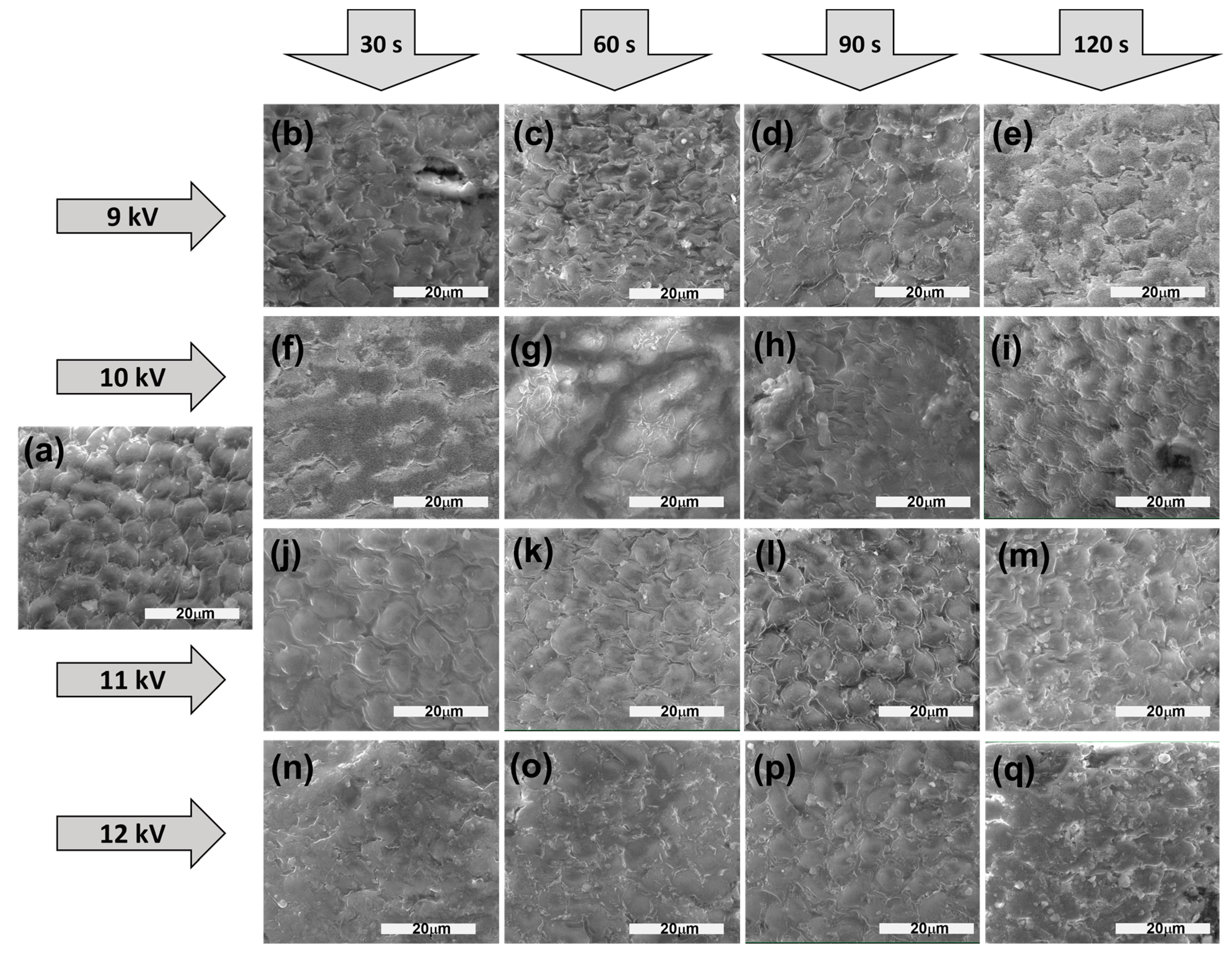
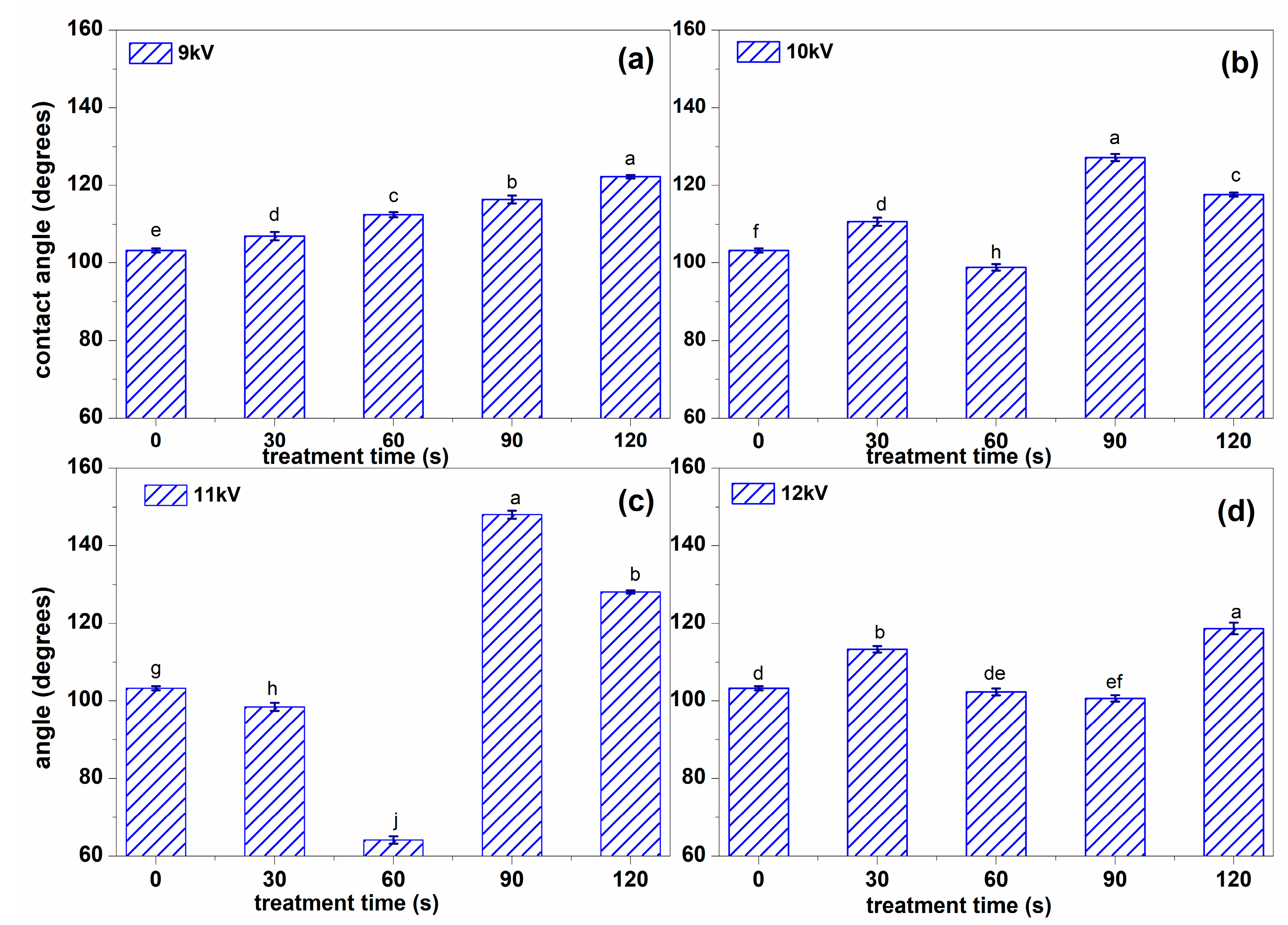
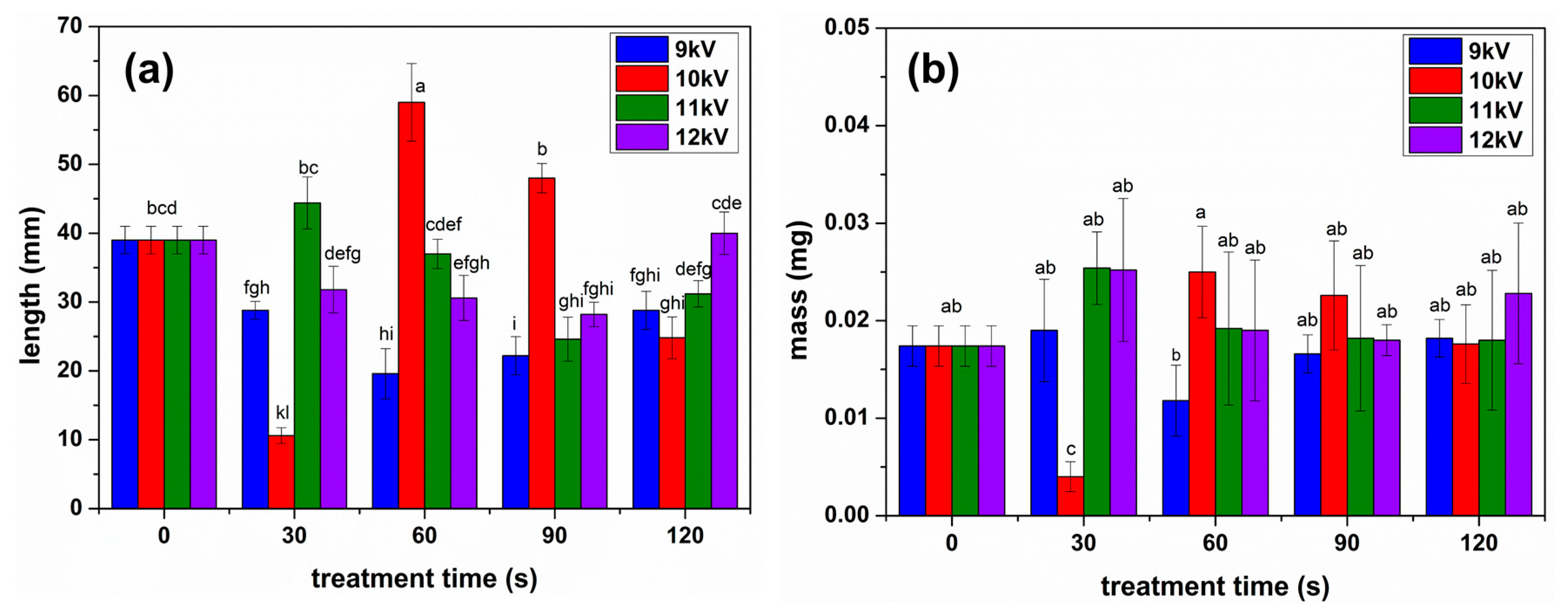

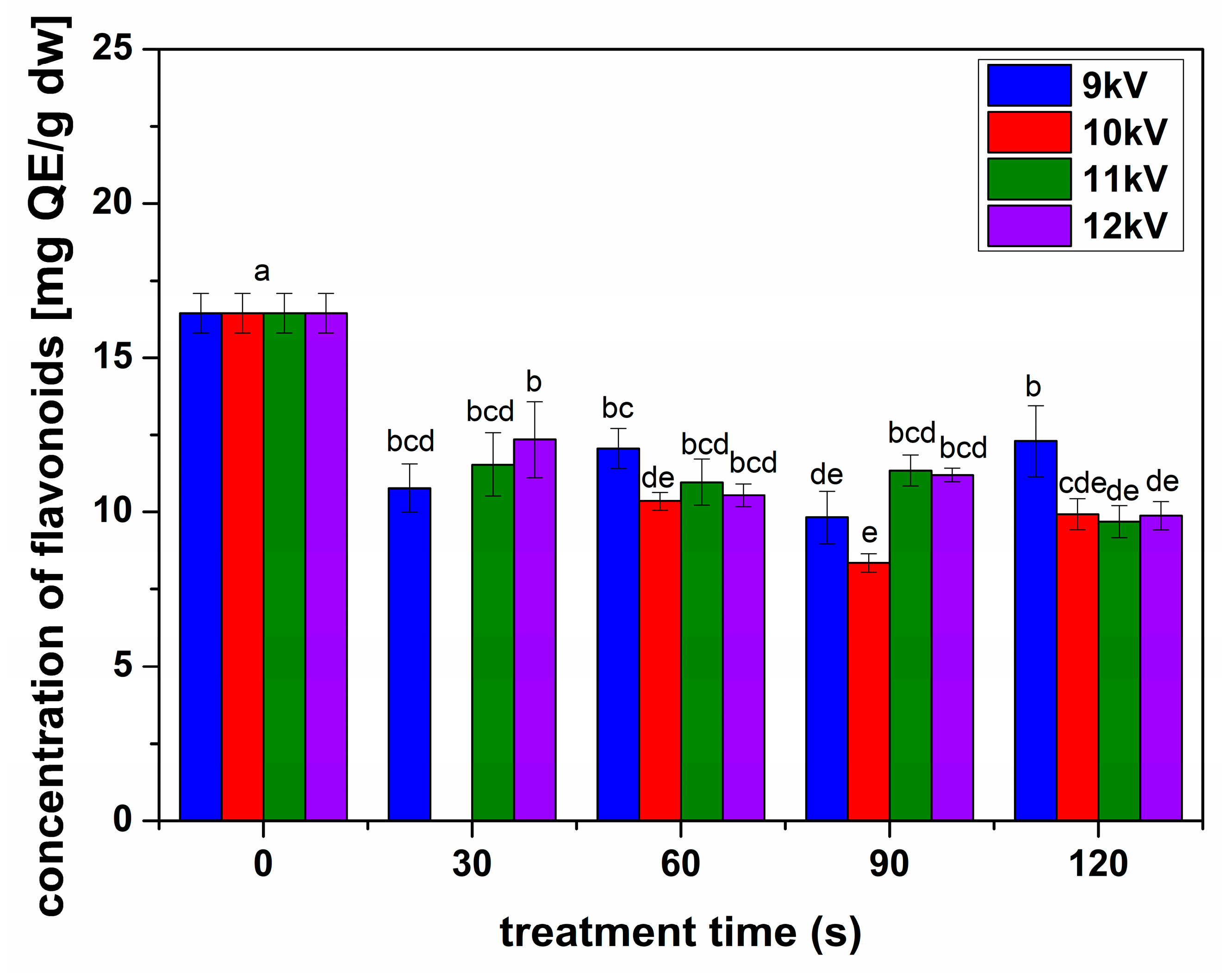
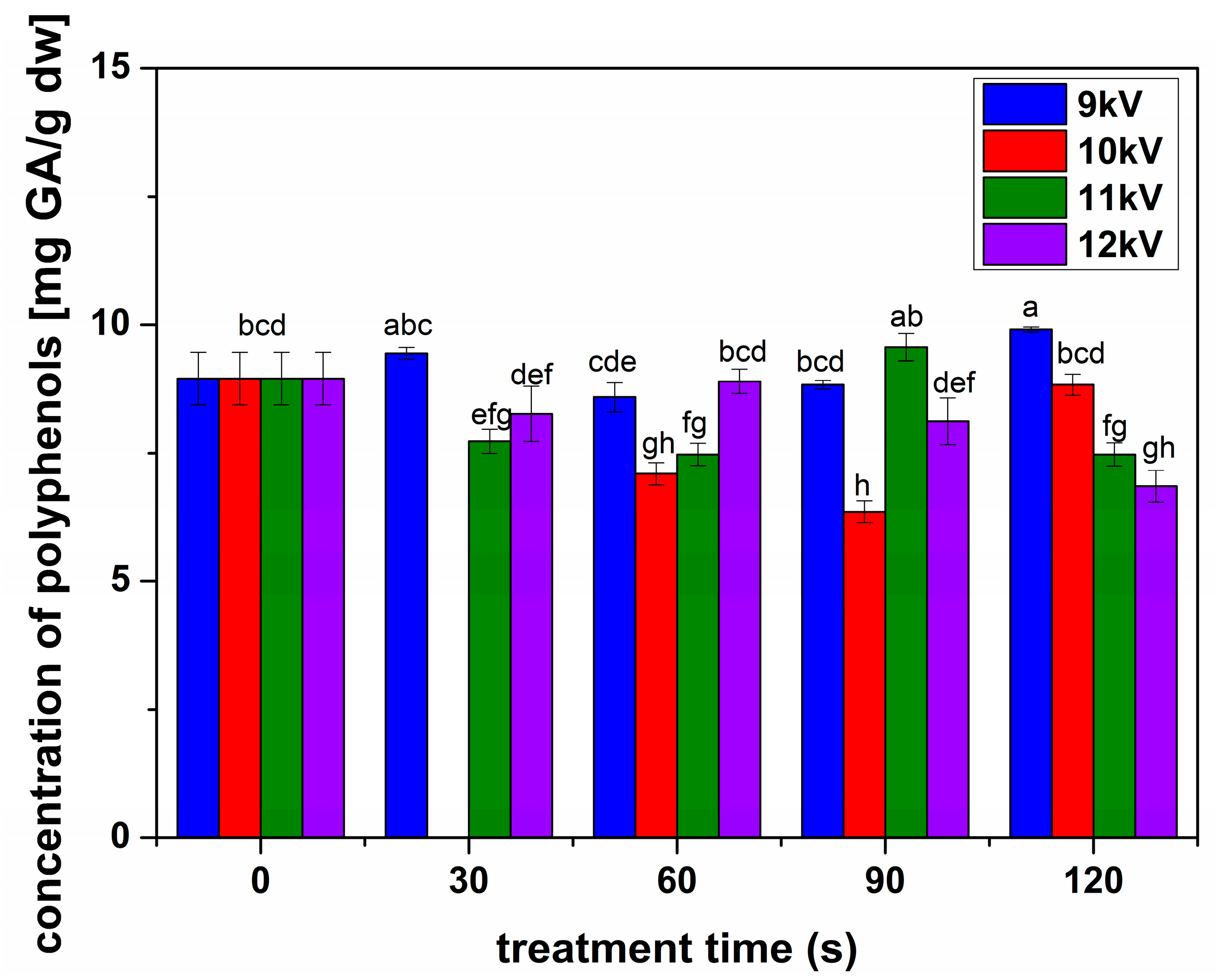
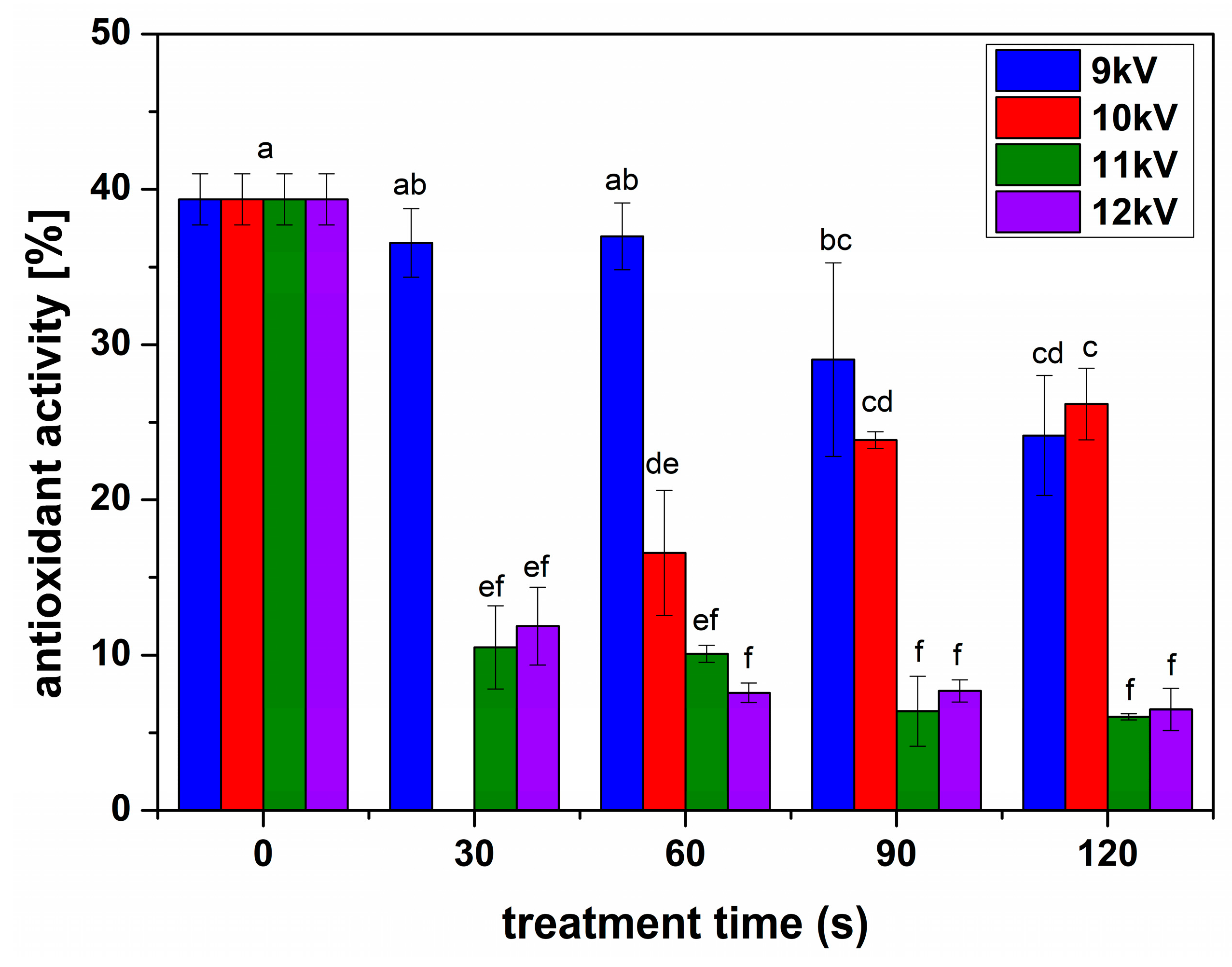
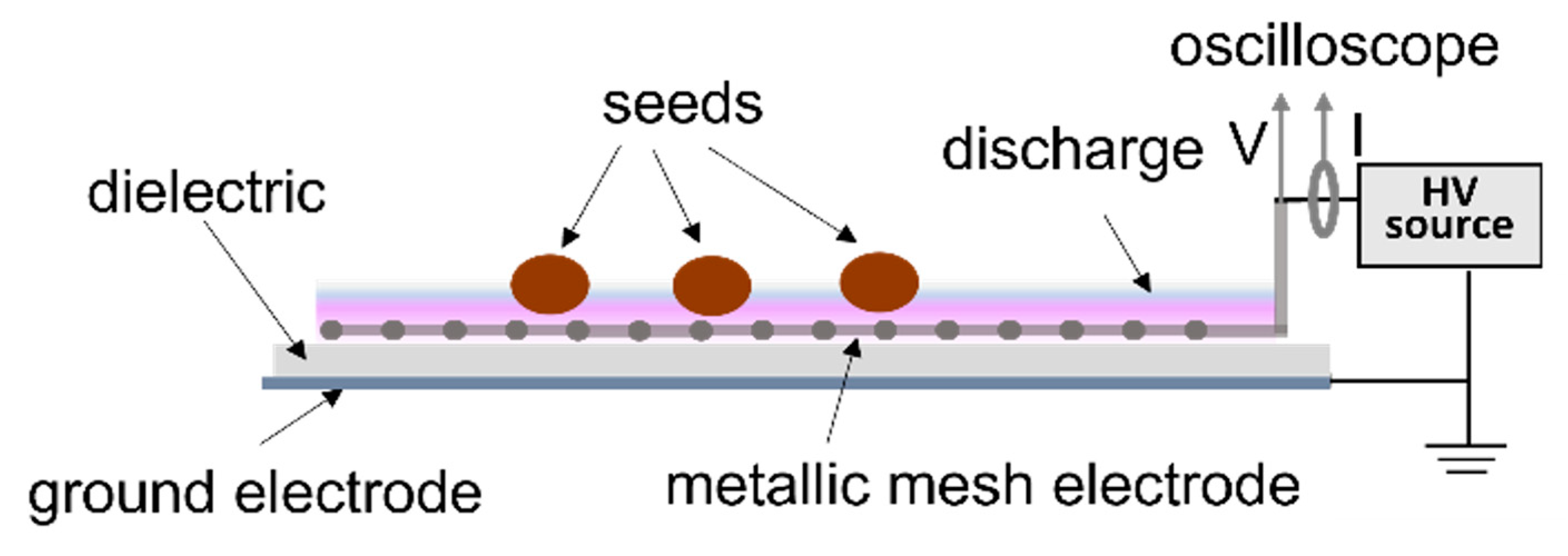
| Correlations 9 kV NTP | ||||||||||
|---|---|---|---|---|---|---|---|---|---|---|
| Time | Contact Ang. | Mass | Length | Phenols | Flavonoids | ch. a | ch. b | Carotenoids | Antiox. Act. | |
| time | 1 | 0.994 (**) | 0.258 | −0.100 | 0.355 | 0.260 | −0.265 | −0.219 | 0.475 | −0.940 |
| contact ang. | 0.994 (**) | 1 | 0.205 | −0.054 | 0.388 | 0.363 | −0.177 | −0.128 | 0.460 | −0.921 |
| mass | 0.258 | 0.205 | 1 | 0.527 | 0.675 | −0.474 | −0.012 | −0.884 | 0.909 | −0.569 |
| length | −0.100 | −0.054 | 0.527 | 1 | 0.891 | 0.294 | 0.843 | −0.089 | 0.691 | −0.145 |
| phenols | 0.355 | 0.388 | 0.675 | 0.891 | 1 | 0.317 | 0.628 | −0.262 | 0.899 | −0.578 |
| flavonoids | 0.260 | 0.363 | −0.474 | 0.294 | 0.317 | 1 | 0.655 | 0.790 | −0.068 | −0.100 |
| ch. a | −0.265 | −0.177 | −0.012 | 0.843 | 0.628 | 0.655 | 1 | 0.457 | 0.244 | 0.176 |
| ch. b | −0.219 | −0.128 | −0.884 | −0.089 | −0.262 | 0.790 | 0.457 | 1 | −0.645 | 0.469 |
| carotenoids | 0.475 | 0.460 | 0.909 | 0.691 | 0.899 | −0.068 | 0.244 | −0.645 | 1 | −0.740 |
| antiox. act. | −0.940 | −0.921 | −0.569 | −0.145 | −0.578 | −0.100 | 0.176 | 0.469 | −0.740 | 1 |
| Correlations 10 kV | ||||||||||
|---|---|---|---|---|---|---|---|---|---|---|
| Time | Contact Ang. | Mass | Length | Phenols | Flavonoids | ch. a | ch. b | Carotenoids | Antiox. Act. | |
| time | 1 | 0.648 | −0.964 | −0.991 | 0.682 | −0.204 | −0.913 | −0.863 | −0.999 (*) | 0.958 |
| contact ang. | 0.648 | 1 | −0.828 | −0.537 | −0.115 | −0.878 | −0.282 | −0.173 | −0.683 | 0.838 |
| mass | −0.964 | −0.828 | 1 | 0.918 | −0.462 | 0.458 | 0.771 | 0.696 | 0.975 | −1.000 (*) |
| length | −0.991 | −0.537 | 0.918 | 1 | −0.776 | 0.068 | 0.961 | 0.924 | 0.983 | −0.910 |
| phenols | 0.682 | −0.115 | −0.462 | −0.776 | 1 | 0.576 | −0.921 | −0.958 | −0.647 | 0.445 |
| flavonoids | −0.204 | −0.878 | 0.458 | 0.068 | 0.576 | 1 | −0.212 | −0.319 | 0.250 | −0.475 |
| ch. a | −0.913 | −0.282 | 0.771 | 0.961 | −0.921 | −0.212 | 1 | 0.994 | 0.893 | −0.759 |
| ch. b | −0.863 | −0.173 | 0.696 | 0.924 | −0.958 | −0.319 | 0.994 | 1 | 0.838 | −0.682 |
| carotenoids | −0.999 (*) | −0.683 | 0.975 | 0.983 | −0.647 | 0.250 | 0.893 | 0.838 | 1 | −0.971 |
| antiox. act. | 0.958 | 0.838 | −1 (*) | −0.910 | 0.445 | −0.475 | −0.759 | −0.682 | −0.971 | 1 |
| Correlations 11 kV | ||||||||||
|---|---|---|---|---|---|---|---|---|---|---|
| Time | Contact ang. | Mass | Length | Phenols | Flavonoids | ch. a | ch. b | Carotenoids | Antiox. Act. | |
| time | 1 | 0.604 | −0.727 | −0.724 | 0.170 | −0.802 | −0.600 | −0.745 | −0.700 | −0.933 |
| contact ang. | 0.604 | 1 | −0.233 | −0.667 | 0.701 | −0.162 | 0.089 | −0.119 | −0.268 | −0.847 |
| mass | −0.727 | −0.233 | 1 | 0.851 | −0.336 | 0.408 | 0.223 | 0.316 | 0.122 | 0.623 |
| length | −0.724 | −0.667 | 0.851 | 1 | −0.740 | 0.189 | −0.083 | 0.092 | 0.020 | 0.814 |
| phenols | 0.170 | 0.701 | −0.336 | −0.740 | 1 | 0.447 | 0.684 | 0.518 | 0.465 | −0.463 |
| flavonoids | −0.802 | −0.162 | 0.408 | 0.189 | 0.447 | 1 | 0.959 (*) | 0.995 (**) | 0.942 | 0.579 |
| ch. a | −0.600 | 0.089 | 0.223 | −0.083 | 0.684 | 0.959 (*) | 1 | 0.977 (*) | 0.919 | 0.325 |
| ch. b | −0.745 | −0.119 | 0.316 | 0.092 | 0.518 | 0.995 (**) | 0.977 (*) | 1 | 0.961 (*) | 0.517 |
| carotenoids | −0.700 | −0.268 | 0.122 | 0.020 | 0.465 | 0.942 | 0.919 | 0.961 (*) | 1 | 0.544 |
| antiox. act. | −0.933 | −0.847 | 0.623 | 0.814 | −0.463 | 0.579 | 0.325 | 0.517 | 0.544 | 1 |
| Correlations 12 kV | ||||||||||
|---|---|---|---|---|---|---|---|---|---|---|
| Time | Contact ang. | Mass | Length | Phenols | Flavonoids | ch. a | ch. b | Carotenoids | Antiox. Act. | |
| time | 1 | 0.195 | −0.438 | 0.550 | −0.755 | −0.827 | −0.583 | −0.364 | 0.166 | −0.872 |
| contact ang. | 0.195 | 1 | 0.756 | 0.895 | −0.751 | −0.110 | −0.490 | −0.391 | 0.355 | 0.154 |
| mass | −0.438 | 0.756 | 1 | 0.387 | −0.258 | 0.557 | −0.266 | −0.355 | −0.039 | 0.762 |
| length | 0.550 | 0.895 | 0.387 | 1 | −0.856 | −0.542 | −0.462 | −0.260 | 0.571 | −0.297 |
| phenols | −0.755 | −0.751 | −0.258 | −0.856 | 1 | 0.465 | 0.838 | 0.673 | −0.117 | 0.373 |
| flavonoids | −0.827 | −0.110 | 0.557 | −0.542 | 0.465 | 1 | 0.061 | −0.205 | −0.640 | 0.941 |
| ch. a | −0.583 | −0.490 | −0.266 | −0.462 | 0.838 | 0.061 | 1 | 0.962 (*) | 0.443 | 0.122 |
| ch. b | −0.364 | −0.391 | −0.355 | −0.260 | 0.673 | −0.205 | 0.962 (*) | 1 | 0.643 | −0.107 |
| carotenoids | 0.166 | 0.355 | −0.039 | 0.571 | −0.117 | −0.640 | 0.443 | 0.643 | 1 | −0.372 |
| antiox. act. | −0.872 | 0.154 | 0.762 | −0.297 | 0.373 | 0.941 | 0.122 | −0.107 | −0.372 | 1 |
Disclaimer/Publisher’s Note: The statements, opinions and data contained in all publications are solely those of the individual author(s) and contributor(s) and not of MDPI and/or the editor(s). MDPI and/or the editor(s) disclaim responsibility for any injury to people or property resulting from any ideas, methods, instructions or products referred to in the content. |
© 2024 by the authors. Licensee MDPI, Basel, Switzerland. This article is an open access article distributed under the terms and conditions of the Creative Commons Attribution (CC BY) license (https://creativecommons.org/licenses/by/4.0/).
Share and Cite
Motrescu, I.; Lungoci, C.; Calistru, A.E.; Luchian, C.E.; Gocan, T.M.; Rimbu, C.M.; Bulgariu, E.; Ciolan, M.A.; Jitareanu, G. Non-Thermal Plasma (NTP) Treatment of Alfalfa Seeds in Different Voltage Conditions Leads to Both Positive and Inhibitory Outcomes Related to Sprout Growth and Nutraceutical Properties. Plants 2024, 13, 1140. https://doi.org/10.3390/plants13081140
Motrescu I, Lungoci C, Calistru AE, Luchian CE, Gocan TM, Rimbu CM, Bulgariu E, Ciolan MA, Jitareanu G. Non-Thermal Plasma (NTP) Treatment of Alfalfa Seeds in Different Voltage Conditions Leads to Both Positive and Inhibitory Outcomes Related to Sprout Growth and Nutraceutical Properties. Plants. 2024; 13(8):1140. https://doi.org/10.3390/plants13081140
Chicago/Turabian StyleMotrescu, Iuliana, Constantin Lungoci, Anca Elena Calistru, Camelia Elena Luchian, Tincuta Marta Gocan, Cristina Mihaela Rimbu, Emilian Bulgariu, Mihai Alexandru Ciolan, and Gerard Jitareanu. 2024. "Non-Thermal Plasma (NTP) Treatment of Alfalfa Seeds in Different Voltage Conditions Leads to Both Positive and Inhibitory Outcomes Related to Sprout Growth and Nutraceutical Properties" Plants 13, no. 8: 1140. https://doi.org/10.3390/plants13081140
APA StyleMotrescu, I., Lungoci, C., Calistru, A. E., Luchian, C. E., Gocan, T. M., Rimbu, C. M., Bulgariu, E., Ciolan, M. A., & Jitareanu, G. (2024). Non-Thermal Plasma (NTP) Treatment of Alfalfa Seeds in Different Voltage Conditions Leads to Both Positive and Inhibitory Outcomes Related to Sprout Growth and Nutraceutical Properties. Plants, 13(8), 1140. https://doi.org/10.3390/plants13081140









